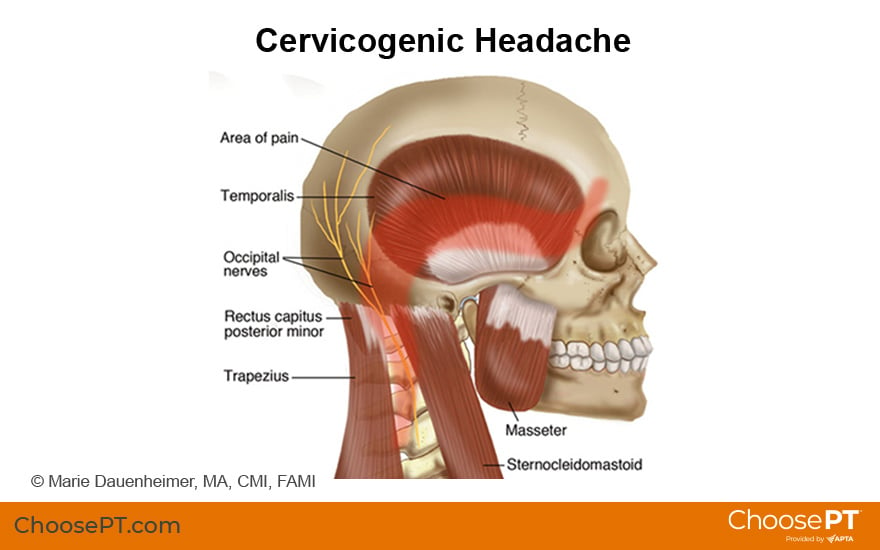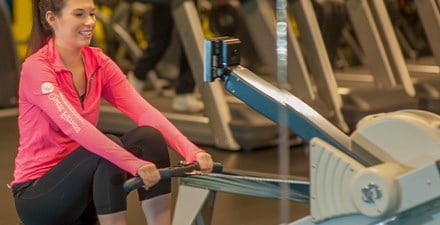Physical Therapy Guide to Headaches
Pain of any type that occurs in any part of the head is called a headache. There are many different types of headaches, with just as many causes. The International Headache Society describes several different categories of headache:
- Cervicogenic (also called muscle-spasm headaches).
- Migraine and cluster.
- Cranial neuralgias, facial pain, and other headaches.
- Secondary headaches from an underlying condition, such as fever, infectious disease, sinus disorder, or in rare cases, a tumor or more serious illness.
- Headaches are a common occurrence in individuals with known neurological conditions such as multiple sclerosis, stroke, or a traumatic brain injury or spinal cord injury.
- Individuals who have a known neurological condition should notify their health care provider if headaches occur.
Most headaches are harmless and resolve on their own, although severe headaches that recur frequently can affect your ability to do your daily activities, and can reduce your quality of life.
There is effective treatment for almost every type of headache. The challenge lies in determining the type of headache, its cause, and in developing an appropriate treatment plan that will reduce both its frequency and intensity. Physical therapists can help determine the type of headache you have, and are experts in managing pain from a variety of sources.
Physical therapists are movement experts. They improve quality of life through hands-on care, patient education, and prescribed movement. You can contact a physical therapist directly for an evaluation. To find a physical therapist in your area, visit Find a PT.
What Are Headaches?
Headaches, like back pain, are one of the most common of all physical complaints and can be one of the most frustrating to manage. Pain of any type that occurs in any part of the head is called a headache.
Muscle-spasm headaches (cervicogenic) are the most common types of headaches in adults. They may be the result of a neck or jaw problem, poor posture, fatigue, or stress.
A problem in the neck, head, or jaw — such as an injury or arthritis — can lead to tension in the muscles at the back of the head and to increased pressure on the nerves to the face and head. Poor posture can cause these muscles to become overworked, which can trigger a headache.

How Does It Feel?
A muscle-spasm headache typically begins at the back of the head and spreads to the top of the head and the eyes. You might feel an increase in facial pain along the cheeks near the jaw bone (temporomandibular disorder). People often describe a tightness, a sensation of someone tugging on their hair, or a feeling of wearing a tight cap. These headaches can worsen with specific positions — such as sitting at a desk — and may ease with rest.
How Can a Physical Therapist Help?
Your physical therapist will conduct a thorough examination that includes a review of your health history. They will ask you questions and perform tests to determine the most likely cause of your headaches.
For example, your physical therapist may ask you to:
- Recall any previous injuries to your neck, head, or jaw.
- Describe the location, nature, and behavior of your pain and other symptoms.
- Draw your areas of pain on a body diagram.
In addition, your physical therapist will:
- Perform tests of muscle strength and sensation.
- Examine your posture when sitting, standing, and performing various activities.
- Measure the range of motion of your neck, shoulders, and other relevant parts of your body.
- Use manual therapy to evaluate the mobility of the joints and muscles in your neck.
If it appears that you do have muscle-spasm headaches, your physical therapist will work with you to design a plan of care to meet your goals. If you have a different type of headache — such as sinus, migraine, or cluster headache — your physical therapist will provide education and therapy that are most effective when combined with other treatments, like medication. Your physical therapist may refer you to another health care provider for further treatment.
Your physical therapist will work with you to correct the problems that are causing your pain and help you learn to prevent headaches, possibly through simple changes in your posture and lifestyle. Physical therapy sessions can help you:
Improve neck mobility. Physical therapists use a specialized technique called manual therapy to increase movement and relieve pain and to stretch the muscles of the back of the neck.
Improve your strength. Your physical therapist will teach you exercises to increase the strength of the muscles that help stabilize your upper back and neck to improve your posture and endurance and make it easier for you to sit or stand for longer periods of time without discomfort.
Improve your posture. Physical therapists will teach you ways to improve your posture. Whether it is simply pushing your chest out or pulling your shoulder blades backward and together, slight modifications to everyday living can make a vast improvement in posture.
Reduce stress. Increased stress can increase the tension in your shoulder and neck muscles, which contributes to headaches. A physical therapist can help you develop a plan to exercise or be physically active on a regular basis to help reduce stress and muscle tension.
Modify your workstation, office, or home office as needed. Your physical therapist’s tips may include:
- Using a headset instead of a regular phone.
- Adjusting your computer screen so that it is no lower than the level of your eyes.
- Finding an appropriate desk chair.
- Adjusting the position of your computer mouse.
What Kind of Physical Therapist Do I Need?
All physical therapists are prepared through education and experience to treat a variety of conditions or injuries. You may want to consider:
- A physical therapist who is experienced in treating people with musculoskeletal problems. Some physical therapists have a practice with a craniofacial focus, meaning that they focus on movement disorders related to the skull and facial structures.
- A physical therapist who is a board-certified clinical specialist or who has completed a residency or fellowship in orthopedic physical therapy or neurologic physical therapy. This physical therapist has advanced knowledge, experience, and skills that may apply to your condition.
You can find physical therapists who have these and other credentials by using Find a PT, the online tool built by the American Physical Therapy Association to help you search for physical therapists with specific clinical expertise in your geographic area.
General tips when you're looking for a physical therapist (or any other health care provider):
- Get recommendations from family, friends, or other health care providers.
- When you contact a physical therapy clinic for an appointment, ask about the physical therapists' experience in helping people with headaches.
- Be prepared to describe your symptoms in as much detail as possible, and say what makes your symptoms worse.
The American Physical Therapy Association believes that consumers should have access to information that could help them make health care decisions and also prepare them for a visit with their health care provider.
APTA has determined that the following articles provide some of the best scientific evidence on how to treat headache. The articles report recent research and give an overview of the standards of practice for treatment both in the United States and internationally. The articles line to a PubMed* abstract of the article, which may provide free access to the full article, so that you can read it or print out a copy to bring with you to your health care provider.
Oguz AE, Baykan B, Ertas M, et al. The persistence versus interchangeability of migraine and tension-type headaches in a 5-year population-based validated survey. Cephalalgia. 2019;40:39–48. Article Summary on PubMed.
Straube A, Andreou A. Primary headaches during lifespan [published correction in J Headache Pain. 2019;20(1):71). J Headache Pain. 2019;20(1):35. Article Summary on PubMed.
Burch R. Migraine and tension-type headache: diagnosis and treatment. Med Clin North Am. 2019;103(2):215–233. Article Summary on PubMed.
Liang Z, galea O, Thomas L, Jull G, Treleaven J. Cervical musculoskeletal impairments in migraine and tension type headache: a systematic review and meta-analysis. Musculoskelet Sci Pract. 2019;42:67–83. Article Summary on PubMed.
Szikszay TM, Hoenick S, von Korn K, et al. Which examination tests detect differences in cervical musculoskeletal impairments in people with migraine? A systematic review and meta-analysis. Phys Ther. 2019;99(5):549–569. Article Summary on PubMed.
Maistrello LF, Rafanelli M, Turolla A. Manual therapy and quality of life in people with headache: systematic review and meta-analysis of randomized controlled trials. Curr Pain Headache Rep. 2019;23(10):78. Article Summary on PubMed.
De Leeuw R, Klasser GD, eds. "Orofacial Pain: Guidelines for Assessment, Diagnosis, and Management." Chicago, IL: Quintessence Publishing USA; 2018.
*PubMed is a free online resource developed by the National Center for Biotechnology Information. PubMed contains millions of citations to biomedical literature, including citations in the National Library of Medicine’s MEDLINE database.
Expert Review:
Sep 15, 2020
Revised:
Sep 15, 2020
Content Type: Guide
Headaches
PT, DPT
Kimberly Miczak
PT, MSPT, board-certified clinical specialist in neurologic physical therapy, on behalf of the Academy of Neurologic Physical Therapy
You Might Also Like...
Patient Stories
Physical Therapy Helps Teenager Return to School and LifeJul 29, 2021
"Physical therapy was the thing that helped me the most."
Podcast
Physical Therapy Can Improve or Wipe Out Many HeadachesJun 3, 2021
Learn about the kinds of headaches physical therapist can treat.
Podcast
Headaches and Physical TherapyFeb 5, 2019
Headaches that last may need treatment by a physical therapist — or referral to another health care provider.


